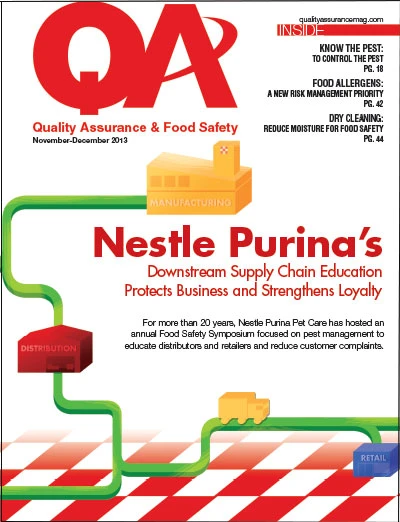 With the prevalence of food allergies continuously rising in the U.S. and unlabeled allergens a top recall issue, legislation and guidelines have become a top priority for a number of federal agencies: USDA has increased its focus on allergens in its inspections; FDA is requiring food allergen controls for labeling in the Food Safety Modernization Act (FSMA), and CDC recently published guidelines for food allergy controls in school. (See Legislative Update, page 6)
With the prevalence of food allergies continuously rising in the U.S. and unlabeled allergens a top recall issue, legislation and guidelines have become a top priority for a number of federal agencies: USDA has increased its focus on allergens in its inspections; FDA is requiring food allergen controls for labeling in the Food Safety Modernization Act (FSMA), and CDC recently published guidelines for food allergy controls in school. (See Legislative Update, page 6)
Labeling.
As described in the FSMA Proposed Rule for Preventive Controls for Human Food: Current Good Manufacturing Practice and Hazard Analysis and Risk-Based Preventive Controls for Human Food, the most common cGMP-related problem resulting in a recall is that of mislabeling (i.e., undeclared allergen). During the period 1999-2003, labeling problems accounted for 34 percent of recalls due to undeclared major food allergens. In a 2008-2009 follow-up review, labeling problems accounted for 43 percent of recalls due to undeclared major food allergens. Because there is no cure, the only option for those with food allergies is to avoid the food, and to do so, they have to rely on food labels being complete, clear, and accurate. Thus, for consumer safety, manufacturers need to have controls to ensure that labels declare all the food allergens that are intended to be present, the correct label is applied to the product, and cross-contact of unintended food allergens is prevented.
As such, Proposed §117.135(d)(2)(ii) would require that food allergen controls for labeling of finished food prevent application of the wrong label to a food, use of wrong packaging, and use of packaging with an incorrect allergen declaration. Additionally, the rule proposes the revision of several provisions of cGMP part 110 to explicitly address cross-contact, make it clear that cGMPs require protection against cross-contact, and ensure that they continue to address health concerns related to allergens.
 Proposed Revisions.
Proposed Revisions.
To identify the cGMP to be revised, detail the proposed requirement, clarify the reasoning for the requirement, and explain the proposed revisions and associated action(s), FDA created a table outlining these for each proposed revision. For example, the cGMP § 110.10(b) & (b)(9) Cleanliness is revised in Section XI.E.1. FDA’s reasoning for the revision is that “Poor hygiene may result in the transfer of food allergens from persons working in direct contact with food, food-contact surfaces, and food-packaging materials to food.”
The requirements for action are:
- All persons working in direct contact with food, food-contact surfaces, and food-packaging materials must conform to hygienic practices while on duty to the extent necessary to protect against cross-contact and contamination of food.
- All such persons must take any other necessary precautions to protect against the cross-contact of food.
Although FDA notes that the table does not include all requirements for allergen controls, stating that readers should visit www.federalregister.gov for the complete rule, the details of the table do provide a great deal of information and a good starting point in preparing for implementation of the final FSMA rules related to allergens. The table is available at www.qualityassurancemag.com/Magazine; November/December 2013, Online Extras.
9 Steps to Reduce Allergen Risk
1. R&D
|
The author is Editor of QA magazine. She can be reached at llupo@gie.net

Explore the December 2013 Issue
Check out more from this issue and find your next story to read.
Latest from Quality Assurance & Food Safety
- Chef Robotics Introduces Pat-Down Capability for Meal Presentation and Sealing
- USDA Launches Regenerative Pilot Program
- Indoor Ag-Con Adds Food Safety Track to Conference Lineup
- IDFA Recognizes Federal Officials for Support of U.S. Dairy Industry
- Tetra Pak Acquires Bioreactors.net
- Fresh Del Monte Receives Rabobank Leadership Award
- São Paulo Earns Guinness World Record for Largest Municipal Food Security Program
- KPM Analytics Releases Ready-to-Use NIR Calibration Packages





